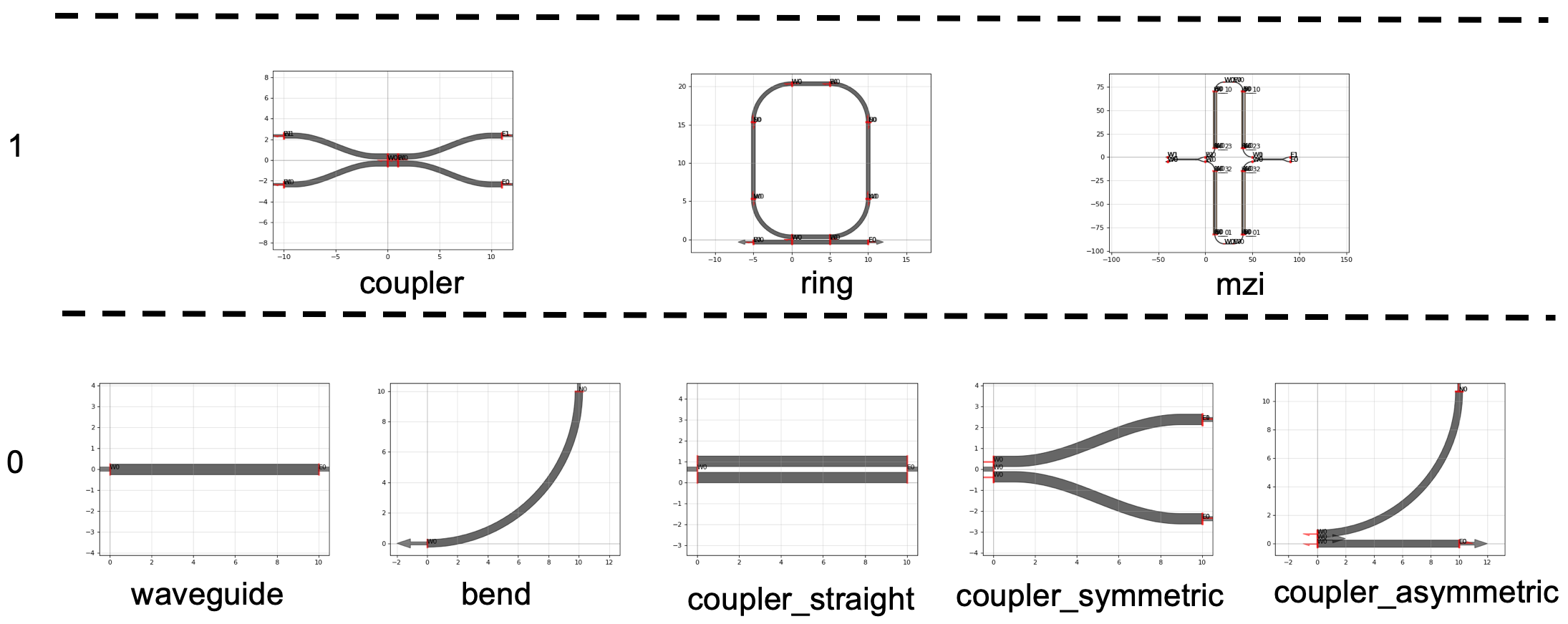
You can define components Parametric cells (waveguides, bends, couplers) with basic input parameters (width, length, radius ...) and reuse the PCells in more complex PCells.
from functools import partial
import toolz
import gdsfactory as gf
from gdsfactory.generic_tech import get_generic_pdk
from gdsfactory.typings import ComponentSpec, CrossSectionSpec
gf.config.rich_output()
PDK = get_generic_pdk()
PDK.activate()2023-12-09 17:30:07.598 | INFO | gdsfactory.technology.layer_views:__init__:790 - Importing LayerViews from YAML file: '/home/runner/work/gdsfactory/gdsfactory/gdsfactory/generic_tech/layer_views.yaml'.
2023-12-09 17:30:07.599 | INFO | gdsfactory.pdk:activate:334 - 'generic' PDK is now active
Problem
When using hierarchical cells where you pass N subcells with M parameters you can end up with N*M parameters. This is make code hard to read.
@gf.cell
def bend_with_straight_with_too_many_input_parameters(
bend=gf.components.bend_euler,
straight=gf.components.straight,
length: float = 3,
angle: float = 90.0,
p: float = 0.5,
with_arc_floorplan: bool = True,
npoints: int | None = None,
direction: str = "ccw",
with_bbox: bool = True,
cross_section: CrossSectionSpec = "strip",
) -> gf.Component:
""" "As hierarchical cells become more complex, the number of input parameters can increase significantly."""
c = gf.Component()
b = bend(
angle=angle,
p=p,
with_arc_floorplan=with_arc_floorplan,
npoints=npoints,
direction=direction,
with_bbox=with_bbox,
cross_section=cross_section,
)
s = straight(length=length, with_bbox=with_bbox, cross_section=cross_section)
bref = c << b
sref = c << s
sref.connect("o2", bref.ports["o2"])
c.info["length"] = b.info["length"] + s.info["length"]
return c
c = bend_with_straight_with_too_many_input_parameters()
c.plot()Solution
You can use a ComponentSpec parameter for every subcell. The ComponentSpec can be a dictionary with arbitrary number of settings, a string, or a function.
ComponentSpec¶
When defining a Parametric cell you can use other ComponentSpec as an arguments. It can be a:
- string: function name of a cell registered on the active PDK.
"bend_circular" - dict:
dict(component='bend_circular', settings=dict(radius=20)) - function: Using
functools.partialyou can customize the default parameters of a function.
@gf.cell
def bend_with_straight(
bend: ComponentSpec = gf.components.bend_euler,
straight: ComponentSpec = gf.components.straight,
) -> gf.Component:
"""Much simpler version.
Args:
bend: input bend.
straight: output straight.
"""
c = gf.Component()
b = gf.get_component(bend)
s = gf.get_component(straight)
bref = c << b
sref = c << s
sref.connect("o2", bref.ports["o2"])
c.info["length"] = b.info["length"] + s.info["length"]
return c
c = bend_with_straight()
c.plot()1. string¶
You can use any string registered in the Pdk. Go to the PDK tutorial to learn how to register cells in a PDK.
c = bend_with_straight(bend="bend_circular")
c.plot()2. dict¶
You can pass a dict of settings.
c = bend_with_straight(bend=dict(component="bend_circular", settings=dict(radius=20)))
c.plot()3. function¶
You can pass a function of a function with customized default input parameters from functools import partial
Partial lets you define different default parameters for a function, so you can modify the default settings for each child cell.
c = bend_with_straight(bend=partial(gf.components.bend_circular, radius=30))
c.plot()bend20 = partial(gf.components.bend_circular, radius=20)
b = bend20()
b.plot()type(bend20)bend20.func.__name__bend20.keywordsb = bend_with_straight(bend=bend20)
print(b.metadata["info"]["length"])
b.plot()# You can still modify the bend to have any bend radius
b3 = bend20(radius=10)
b3.plot()PDK custom fab¶
You can define a new PDK by creating function that customize partial parameters of the generic functions.
Lets say that this PDK uses layer (41, 0) for the pads (instead of the layer used in the generic pad function).
pad_custom_layer = partial(gf.components.pad, layer=(41, 0))c = pad_custom_layer()
c.plot()Composing functions¶
You can combine more complex functions out of smaller functions.
Lets say that we want to add tapers and grating couplers to a wide waveguide.
c1 = gf.components.straight()
c1.plot()straight_wide = partial(gf.components.straight, width=3)
c3 = straight_wide()
c3.plot()c1 = gf.components.straight(width=3)
c1.plot()c2 = gf.add_tapers(c1)
c2.plot()c2.metadata_child["changed"] # You can still access the child metadatac3 = gf.routing.add_fiber_array(c2, with_loopback=False)
c3.plot()c3.metadata_child["changed"] # You can still access the child metadataLets do it with a single step thanks to toolz.pipe
add_fiber_array = partial(gf.routing.add_fiber_array, with_loopback=False)
add_tapers = gf.add_tapers
# pipe is more readable than the equivalent add_fiber_array(add_tapers(c1))
c3 = toolz.pipe(c1, add_tapers, add_fiber_array)
c3we can even combine add_tapers and add_fiber_array thanks to toolz.compose or toolz.compose
For example:
add_tapers_fiber_array = toolz.compose_left(add_tapers, add_fiber_array)
c4 = add_tapers_fiber_array(c1)
c4.plot()is equivalent to
c5 = add_fiber_array(add_tapers(c1))
c5.plot()as well as equivalent to
add_tapers_fiber_array = toolz.compose(add_fiber_array, add_tapers)
c6 = add_tapers_fiber_array(c1)
c6.plot()or
c7 = toolz.pipe(c1, add_tapers, add_fiber_array)
c7.plot()c7.metadata_child["changed"] # You can still access the child metadatac7.metadata["child"]["child"]["name"]c7.metadata["child"]["child"]["function_name"]c7.metadata["changed"].keys()